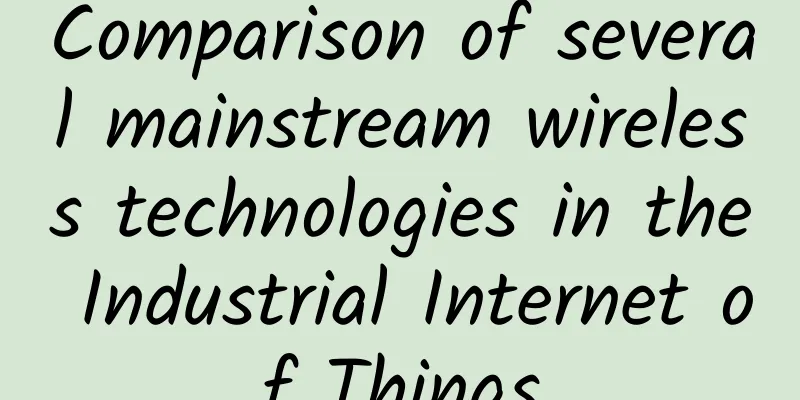Comparison of several mainstream wireless technologies in the Industrial Internet of Things

|
Large-scale production scenarios involve a large number of equipment, production application systems, workers, and products. A stable, high-speed, and easy-to-manage wireless network is an essential requirement. Wireless communication technologies for the Industrial Internet of Things are mainly divided into two categories: one is short-distance communication technologies such as ZigBee, WiFi, and Bluetooth; the other is LPWAN (low-power Wide-Area Network), which is low-power wide-area network communication technology. LPWAN is further divided into two categories: one is technologies such as LoRa and SigFox that work in unlicensed spectrum; the other is 2/3/4G cellular communication technologies supported by 3GPP that work in licensed spectrum, such as EC-GSM, LTE Cat-m, NB-IoT, etc. Different wireless technologies differ in networking, power consumption, communication distance, security, etc., and therefore have different applicable scenarios. For example, Sub-1GHz technology is suitable for applications with long transmission distances, battery power, and robustness; Bluetooth is suitable for high speed, more information transmission, and control via mobile phones; Thread, Wi-Fi and other technologies also have their own advantages and applicable scenarios. Wireless connectivity in Industry 4.0 application scenarios It is worth noting that new wireless technology standards are also emerging. For example, as an extension and supplement to traditional WiFi technology, Wi-Fi HaLow can provide a unique combination of security, long distance, low power consumption and highly optimized wireless connection, which greatly improves the management efficiency of factory automation. Performance comparison of different wireless technologies in the Industrial Internet of Things Transmission rate and distance of different wireless technologies in the Industrial Internet of Things Reception efficiency and distance of different wireless technologies in the Industrial Internet of Things The following are some common wireless technologies in the industrial Internet of Things: ZigBee, Bluetooth, Lora, NB-IoT, Sigfox, and the latest WiFi Halow technology. ZigBee Technology ZigBee was formally proposed in 2003 to make up for the shortcomings of Bluetooth communication protocol, such as high complexity, high power consumption, short distance, and small network scale. The name comes from bees, which rely on flying and "zig" (buzzing) wings to communicate with their companions about the location of pollen, thus forming a communication network in the group. ZigBee can operate in three frequency bands: 868MHz~868.6MHz, 902MHz~928MHz and 2.4GHz~2.4835GHz. The last frequency band is universal worldwide and has 16 channels. It is a free and application-free radio frequency band. The transmission rates of the three frequency bands are 20kbps, 40kbps and 250kbps respectively. ZigBee is a low-cost, low-power, low-power short-range wireless communication standard. It is a wireless network specification designed for low-rate sensors and control networks and has the following characteristics:
Although ZigBee has the advantages of low power consumption, low cost, low rate, high capacity, and long battery life, it also has disadvantages, namely poor anti-interference, short communication distance, and the ZigBee protocol is not open source. Bluetooth Technology Bluetooth technology was first developed in 1994 by telecommunications giant Ericsson. It is the simplest and most convenient way to conduct short-distance wireless communication between two devices, and can achieve short-distance data exchange between fixed devices, mobile devices and building personal area networks. Bluetooth technology is widely used in mobile devices such as mobile phones and PDAs, PCs, GPS devices, and a large number of wireless peripherals (Bluetooth headsets, Bluetooth keyboards, etc.). Bluetooth uses frequency hopping technology, and the communication frequency band is 2.402GHz~2.480GHz. So far, 10 versions have been updated, namely Bluetooth 1.0/1.1/1.2/2.0/2.1/3.0/4.0/4.1/4.2/5.0, and the communication radius extends from a few meters to hundreds of meters. Compared with the previous Bluetooth 4.2 or even older versions, Bluetooth 5.0 has the following features:
The main advantages of Bluetooth technology are that it does not rely on external networks, has fast speed, low power consumption, and high security. As long as you have a mobile phone and smart device, you can maintain a stable connection and connect wherever you go. Its disadvantages are that it cannot directly connect to the cloud, the transmission speed is relatively slow, the networking ability is relatively weak, and there are few network nodes, which is not suitable for multi-point control. LoRa Technology LoRa is an ultra-long-distance, low-power wireless transmission solution based on spread spectrum technology developed and promoted by Semtech in the United States. It provides users with a simple system that can achieve long distance, long battery life, and large capacity, thereby expanding the sensor network. Currently, LoRa mainly operates in the global free frequency band, with an operating frequency of 915MHz in the United States, 868MHz in Europe, and 433MHz in Asia. Its typical range is 2km to 5km, and the longest distance can reach 15km, depending on the location and antenna characteristics. LoRa technology has the following characteristics:
Therefore, LoRa technology is very suitable for IoT applications that require low power consumption, long distance, large number of connections, and positioning tracking, such as parking, vehicle tracking, smart industry, smart cities, smart communities, etc. The disadvantages of LoRa are slow transmission rate, communication frequency band susceptible to interference, chip supply is monopolized by Semtech, the bottom-level development cycle is long, and the network mechanism of self-organizing network is relatively complex. Therefore, most companies are reluctant to study LoRa technology and prefer to buy modules for direct use. NB-IoT Technology NB-IoT (Narrowband Internet of Things) technology originated from a British startup company Neul (acquired by Huawei in 2014), focusing on the low-power and wide-coverage Internet of Things (IoT) market. Instead of using the full 10MHz or 20MHz bandwidth of standard LTE, NB-IoT uses 180kHz-wide resource blocks consisting of 12 15kHz LTE subcarriers, with data rates ranging from 100kb/s to 1Mb/s. NB-IoT uses licensed frequency bands and can be deployed in three ways: in-band, guard band or independent carrier, and coexist with existing networks. As a technology applied to low-rate services, NB-IoT has the following advantages:
Although NB-IoT has many advantages, its low-speed data transmission, privacy and security, and IT system conversion time will limit its development. Sigfox Technology Sigfox is a wireless network built by the French company Sigfox using ultra-narrow band (UNB) technology. It is both a wireless technology and a network service. Sigfox operates in the ISM bands of 868MHz and 902MHz, consuming very narrow bandwidth or power consumption. Sigfox radios use a technique called ultra-narrowband (UNB) modulation to occasionally transmit short messages at a low data rate, with a maximum message length of 12 bytes, and a node can transmit up to 140 messages per day. Due to the narrow bandwidth and short messages, in addition to its 162dB link budget, it can also achieve a long transmission distance of several kilometers. For burst applications that only need to send small, infrequent data, Sigfox is an excellent choice. The downside of Sigfox is that data sent back to the sensor/device (downlink capability) is severely limited and signal interference can also be a problem. HaLow Technology Unstable connection, low efficiency, and intermittent time periods have always been headaches for WiFi technology. HaLow is a new version of WiFi suitable for industrial IoT applications. Codenamed 802.11ah, it enables WiFi to be applied to more places, such as small-sized, battery-powered wearable devices. It is also suitable for deployment in industrial facilities and applications in between.
HaLow uses the 900MHz frequency band, which is lower than the current WiFi 2.4GHz and 5GHz bands, and is more suitable for small data loads and low-power devices. The United States uses the unlicensed band of 902MHz to 928MHz, and other countries use similar bands below 1GHz. Although most WiFi devices can only achieve a maximum coverage range of 100m under ideal conditions, HaLow can reach up to 1km with the right antenna, with stronger signals and less susceptible to interference. HaLow is said to have a transmission distance twice that of standard 2.4GHz WiFi and a stronger ability to penetrate walls. HaLow is not suitable for fast data transmission or web browsing (which has little impact on IoT devices). In addition, 900MHz is an unlicensed frequency band and is susceptible to interference. Comparison of Industrial IoT Wireless Technology Parameters Which technology will win? According to the latest report from market research firm IHS Markit, among low-power wide-area network wireless technologies, LoRa and NB-IoT are far ahead, with the LTE-M version of 4G cellular technology ranking third, followed closely by Sigfox. IHS Markit predicts that NB-IoT and LoRa are expected to account for 86% of all LPWAN links by 2023. 2023 will be a competition between the two technologies, with more private networks adopting LoRa and NB-IoT mainly used in public networks. It is worth mentioning that HiSilicon, a subsidiary of Huawei, is currently the leading supplier of NB-IoT chips, 90% of which are deployed in China; the second largest NB-IoT chip supplier is Taiwan's Mediatek, and the third largest supplier is China's Unisoc. Sigfox, on the other hand, relies mainly on the support of a venture capital company to become a global IoT operator and maintain its proprietary technology. According to a survey report by IHS Markit, Sigfox shipped less than 9,000 modules in 2017, ranking third in market share, far behind LoRa and NB-IoT. IHS Markit predicts that Sigfox's annual sales are expected to grow 10 times by 2021, but it will still rank behind LoRa and NB-IoT. At the same time, the Bluetooth Alliance and the Wi-Fi Alliance have both used their own tricks. The improved signal coverage of Bluetooth 5.0 is said to cover the entire apartment, which is comparable to the data transmission distance of a home WiFi router. HaLow combines the advantages of previous WiFi technology and Bluetooth. In the Industrial Internet of Things, customer needs are rich and diverse, and a single technology cannot solve all customer problems. Different wireless technologies compete with each other, but also complement each other, because in the future of the Industrial Internet of Things, no one communication technology can dominate the world. |
<<: Juniper Networks helps you achieve win-win in the era of enterprise multi-cloud
>>: ACL (Access Control List) Principle and Application
Recommend
edgeNAT July Promotion: 20% off for monthly VPS and 30% off for annual VPS starting from 48 yuan/month, available in China, Hong Kong, and South Korea
edgeNAT has launched a promotion for this month. ...
How to implement TCP connection and communication with Python?
Network connection and communication are the know...
Application of Self-Organizing Network in IOT Devices
Labs Guide In recent years, IoT devices have been...
Fatal question: How many HTTP requests can be sent through a TCP connection?
There was once such an interview question: What h...
RAKsmart: High-security servers from $79/month, cluster servers from $142/month, data centers in the United States/Japan/Korea, etc.
Earlier this month, we shared information about R...
Cisco: Continuous innovation to create an inclusive future
On June 14, Cisco's annual networking and sec...
8 predictions for the development of network technology in 2017
The Internet is evolving at an unprecedented pace...
The number of users is not increasing, the time spent is declining, and 5G applications are delayed. Can we only wait for the flowers to bloom in 2021?
[[397144]] After many twists and turns, the numbe...
LOCVPS 20% off: 29.6 yuan/month - 1GB/30GB/400GB@100Mbps/Osaka, Japan
LOCVPS is a domestic hosting company founded in 2...
A Preliminary Study on Software Defined Network (SDN)
【51CTO.com Quick Translation】Before 2008, the ent...
5 Essential Predictions for Blockchain Trends in 2018
The potential for blockchain technology to bring ...
In 2018, Donghua Network Intelligence built a powerful IT operation and maintenance engine "comprehensive monitoring + process management" which was popular
[51CTO.com original article] In recent years, pro...
ZJI newly launched Taiwan CN2 server, Hong Kong high frequency server/Taiwan CN2 server 30% off
ZJI has newly launched Taiwan CN2 line servers, a...
Cybersecurity is accelerating under the new infrastructure trend
With the accelerated construction of new infrastr...
Linkerd 2.10 (Step by Step)—Install Multi-Cluster Components
[[406693]] The Linkerd 2.10 Chinese manual is bei...









